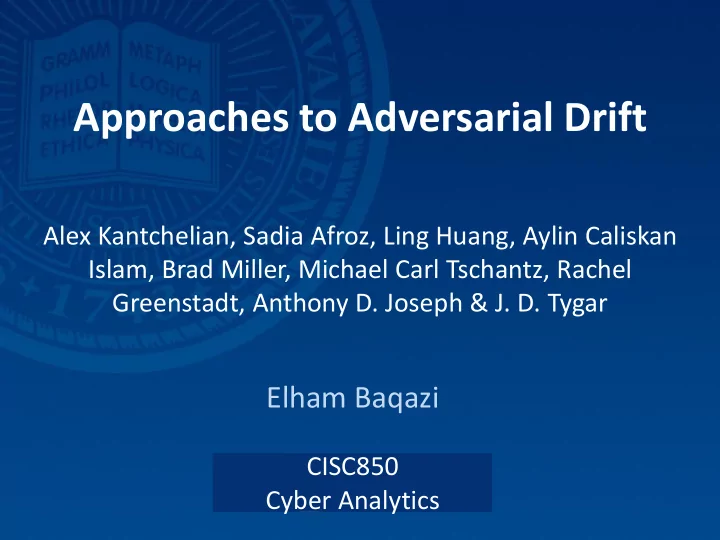

Approaches to Adversarial Drift Alex Kantchelian, Sadia Afroz, Ling Huang, Aylin Caliskan Islam, Brad Miller, Michael Carl Tschantz, Rachel Greenstadt, Anthony D. Joseph & J. D. Tygar Elham Baqazi CISC850 Cyber Analytics
Outline • Challenges of applying ML systems for security applications • Exploratory & Causative attack • Families Isolation & Responsiveness • Data Exploration
Adversarial Drift Designing changes to evade the classifier immediately or to make future evasion easier Handling the adversarial drift
CISC850 Cyber Analytics Machine learning in Security Application One-Shot Approach • Training data • Building the model • Testing data
CISC850 Cyber Analytics Problem Statement Security Apps data: Big & non-stationary data, drift over the time The typical ML approach fail
CISC850 Cyber Analytics Proposed Solution Designing adaptive, adversarial-resistant ML systems • Ensemble of classifiers • Responsive classifier
Formalism Retraining the system to learn from new instances • Producing a series of models H t • H t (x i ) = c(x i ) [correctly classifies ]
Population Drift • X t (x) is the probability of encountering instance “x” at time t • Adversaries post new malware X t+1 • Population Drift X t != X t ’
Types of Attacks Exploratory attacks Causative attacks
Exploratory Attacks https://mascherari.press/introduction-to-adversarial-machine-learning/
Causative Attacks https://mascherari.press/introduction-to-adversarial-machine-learning/
Families and Isolation https://www.researchgate.net/figure/5850993_fig7_Architecture-of-the-ensemble-of-Support-Vector-Machine-classifiers-A-collection-of-m-SVM
Families and Isolation Training classifiers • One-vs-all method • One-vs-good method • Isolation Combining classification
Responsiveness Why it being overlooked? • Zero training error , poor generalization • Unreliable training data. Wrapped ML algorithm • Blacklist & Whitelist
Evaluation Executable malware dataset with chronological appearance for each instance. • Demonstrating the importance of temporal drift in a very adversarial environment. • Improving the robustness of ML algorithms .
Data Exploration - Dataset Sampled from two stratums : • TimeStamp, Label , Feature vector
Top 10 Families
Experiments – Approach An empirical loss minimization approach
Data Exploration – Experiments 1 Splitting the dataset into two epochs [mid-April], 60,000 malware in each period Train two-class SVM models • Regularization factor: 10 −5 < C < 1 • False Positive Rate (FPR) < 1% Calculating the Performance by two ways
Result 1 _ conclusion The evaluation of ML based on security system should • Temporal nature of the instances • Avoid Random-cross-validation
Data Exploration – Experiments 2 Fixed the testing set [most recent instances] Train SVM models Constant C = 10 −4 Constant FPR < 1% Ignore the temporal order
Conclusion Drift must be organized to limit the impact of campaigns Zero training error of high-impact instance means correctly classification Drift and temporal order must be respected in term of detector accuracy
Thank you Questions?
Recommend
More recommend